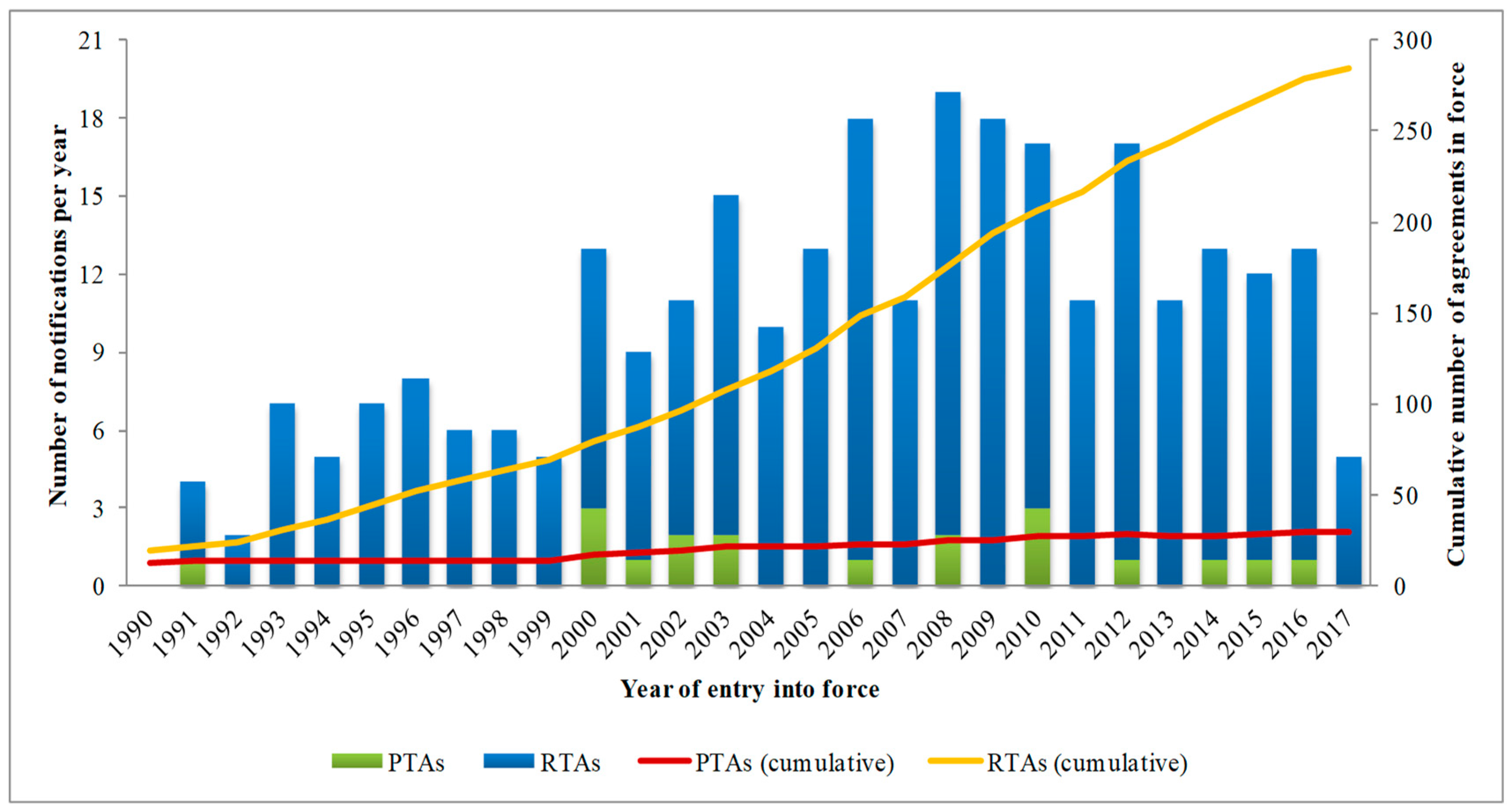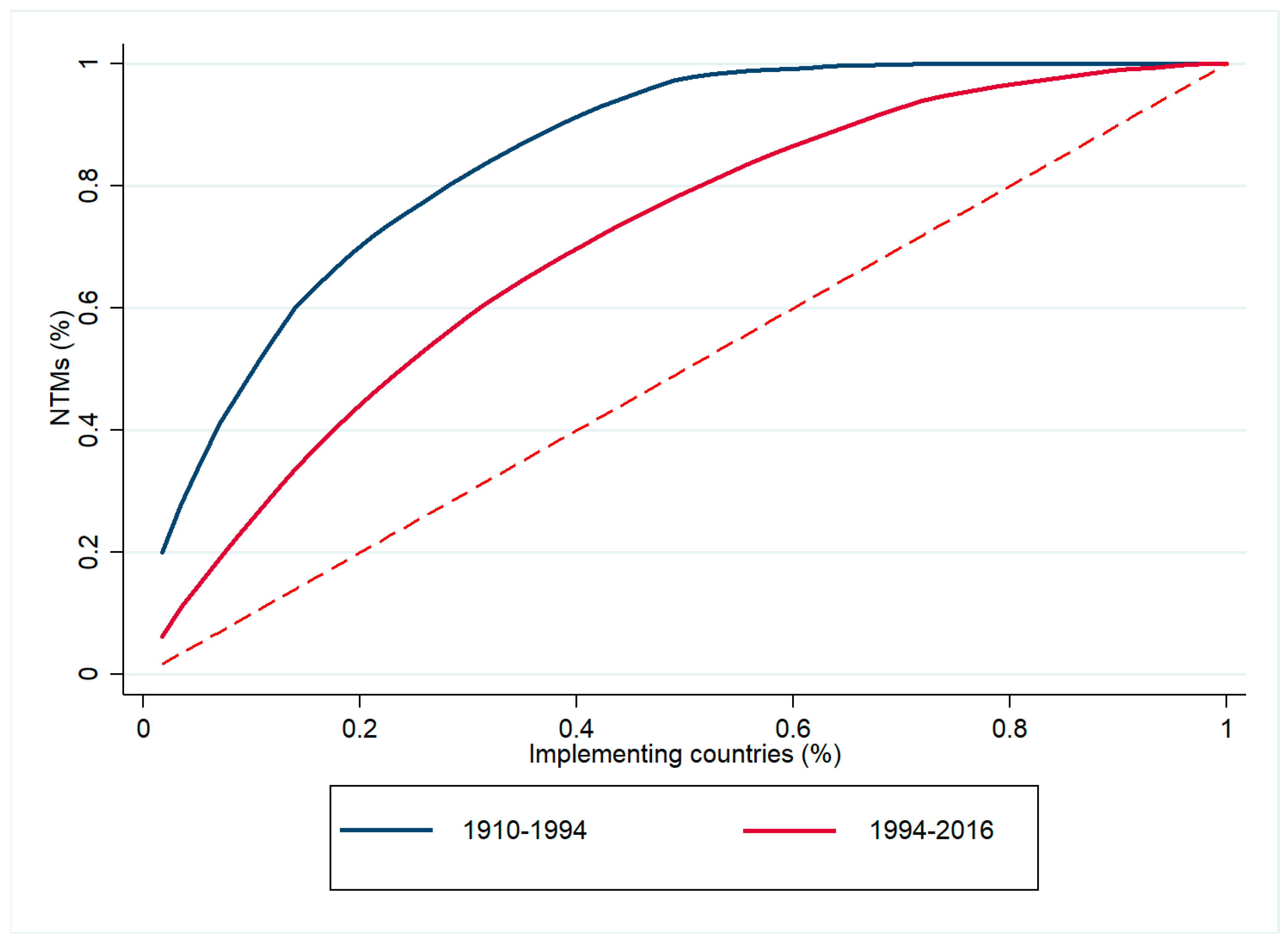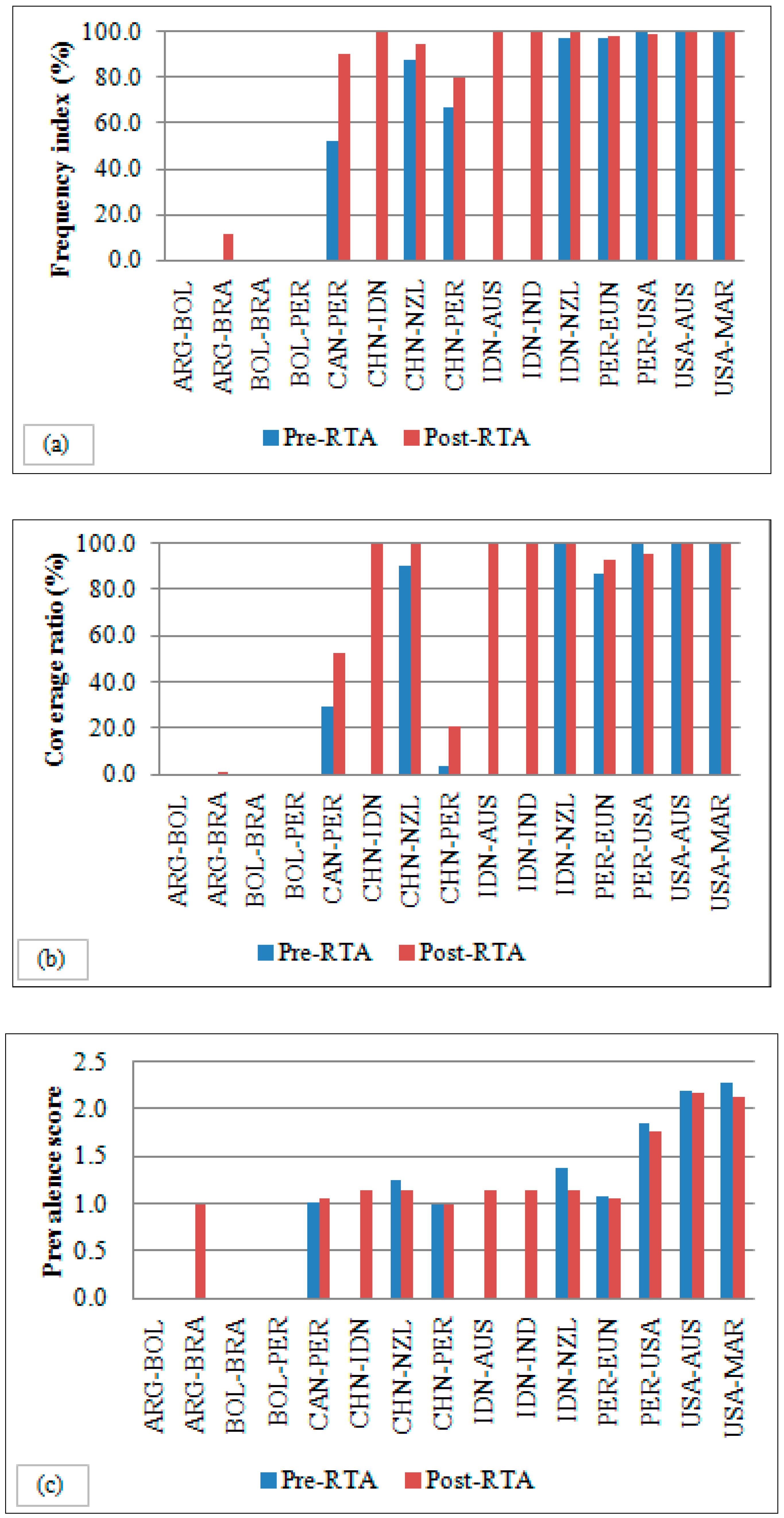On the Evolution of Trade and Sanitary and Phytosanitary Standards: The Role of Trade Agreements
Abstract
1. Introduction
On Trade Agreements and Technical Non-Tariff Measures in the Agri-Food Sector
2. Materials and Methods
2.1. Description of Data
2.2. Inventory Approach
2.3. Empirical Approach
3. Results
3.1. Results of the Inventory Analyses
3.2. Empirical Results
4. Conclusions
Author Contributions
Funding
Acknowledgments
Conflicts of Interest
References
- Henson, S.; Loader, R. Barriers to agricultural exports from developing countries: The role of sanitary and phytosanitary requirements. World Dev. 2001, 29, 85–102. [Google Scholar] [CrossRef]
- Santeramo, F.G. On Non-Tariff Measures and Changes in Trade Routes: From North-North to South-South Trade? International Agricultural Trade Research Consortium: Washington, DC, USA, 2018. [Google Scholar]
- Sun, L.; Reed, M.R. Impacts of free trade agreements on agricultural trade creation and trade diversion. Am. J. Agric. Econ. 2010, 92, 1351–1363. [Google Scholar] [CrossRef]
- Arita, S.; Beckman, J.; Mitchell, L. Reducing transatlantic barriers on US-EU agri-food trade: What are the possible gains? Food Policy 2017, 68, 233–247. [Google Scholar] [CrossRef]
- Díaz-Bonilla, E.; Robinson, S.; Swinnen, J.F. Regional agreements and the World Trade Organization negotiations. Am. J. Agric. Econ. 2003, 85, 679–683. [Google Scholar] [CrossRef]
- Disdier, A.C.; Fontagné, L.; Cadot, O. North-South standards harmonization and international trade. World Bank Econ. Rev. 2015, 29, 327–352. [Google Scholar] [CrossRef]
- Peterson, E.; Grant, J.H.; Roberts, D.; Karov, V. Evaluating the trade restrictiveness of phytosanitary measures on US fresh fruit and vegetable imports. Am. J. Agric. Econ. 2013, 95, 842–858. [Google Scholar] [CrossRef]
- Dal Bianco, A.; Boatto, V.L.; Caracciolo, F.; Santeramo, F.G. Tariffs and non-tariff frictions in the world wine trade. Eur. Rev. Agric. Econ. 2016, 43, 31–57. [Google Scholar] [CrossRef]
- Cardamone, P. The effect of preferential trade agreements on monthly fruit exports to the European Union. Eur. Rev. Agric. Econ. 2011, 38, 553–586. [Google Scholar] [CrossRef]
- Schlueter, S.W.; Wieck, C.; Heckelei, T. Regulatory policies in meat trade: Is there evidence for least trade-distorting sanitary regulations? Am. J. Agric. Econ. 2009, 91, 1484–1490. [Google Scholar] [CrossRef]
- Xiong, B.; Beghin, J. Does European aflatoxin regulation hurt groundnut exporters from Africa? Eur. Rev. Agric. Econ. 2011, 39, 589–609. [Google Scholar] [CrossRef]
- Beckman, J.; Arita, S. Modeling the Interplay between Sanitary and phytosanitary measures and tariff-rate quotas under partial trade liberalization. Am. J. Agric. Econ. 2016, 99, 1078–1095. [Google Scholar] [CrossRef]
- Santeramo, F.G.; Lamonaca, E. The Effects of Non-Tariff Measures on Agri-Food Trade: A Review and Meta-Analysis of Empirical Evidence. Available online: https://arxiv.org/ftp/arxiv/papers/1811/1811.06323.pdf (accessed on 15 November 2018).
- De Frahan, B.H.; Vancauteren, M. Harmonisation of food regulations and trade in the Single Market: Evidence from disaggregated data. Eur. Rev. Agric. Econ. 2006, 33, 337–360. [Google Scholar] [CrossRef]
- Drogué, S.; DeMaria, F. Pesticide residues and trade, the apple of discord? Food Policy 2012, 37, 641–649. [Google Scholar] [CrossRef]
- Grant, J.H. Is the growth of regionalism as significant as the headlines suggest? Lessons from agricultural trade. Agric. Econ. 2013, 44, 93–109. [Google Scholar] [CrossRef]
- Scoppola, M.; Raimondi, V.; Olper, A. The impact of EU trade preferences on the extensive and intensive margins of agricultural and food products. Agric. Econ. 2018, 49, 251–263. [Google Scholar] [CrossRef]
- Imbens, G.W.; Lemieux, T. Regression discontinuity designs: A guide to practice. J. Econ. 2008, 142, 615–635. [Google Scholar] [CrossRef]
- Lee, D.S.; Lemieux, T. Regression discontinuity designs in economics. J. Econ. Lit. 2010, 48, 281–355. [Google Scholar] [CrossRef]
- RTA-IS. The Regional Trade Agreements Information System. Available online: rtais.wto.org/UI/Charts.aspx# (accessed on 15 October 2018).
- WTO. The WTO Database on Preferential Trade Arrangements. Available online: ptadb.wto.org/ptaList.aspx (accessed on 15 October2018).
- OECD. Regional Trade Agreements and Agriculture; OECD Food, Agriculture and Fisheries Papers, No. 79; OECD Publishing: Paris, France, 2015. [Google Scholar]
- Koo, W.W.; Kennedy, P.L.; Skripnitchenko, A. Regional preferential trade agreements: Trade creation and diversion effects. Appl. Econ. Perspect. Policy 2006, 28, 408–415. [Google Scholar] [CrossRef]
- Lambert, D.; McKoy, S. Trade creation and diversion effects of preferential trade associations on agricultural and food trade. J. Agric. Econ. 2009, 60, 17–39. [Google Scholar] [CrossRef]
- United Nations. UNCTAD International Classification of Non-Tariff Measures, February 2012 version (UNCTAD/DITC/TAB/2012/2); United Nations: New York, NY, USA; Geneva, Switzerland, 2012. [Google Scholar]
- UNCTAD. The Global Database on Non-Tariff Measures. Available online: trains.unctad.org/ (accessed on 15 September 2017).
- Bown, C.P.; Crowley, M.A. Emerging economies, trade policy, and macroeconomic shocks. J. Dev. Econ. 2014, 111, 261–273. [Google Scholar] [CrossRef]
- Martin, W. A Research agenda for international agricultural trade. Appl. Econ. Perspect. Policy 2018, 40, 155–173. [Google Scholar] [CrossRef]
- Grant, J.H.; Arita, S. Sanitary and Phyto-Sanitary Measures: Assessment, Measurement, and Impact; IATRC: Washington, DC, USA, 2017; Volume 21, pp. 1–53. [Google Scholar]
- Jongwanich, J. The impact of food safety standards on processed food exports from developing countries. Food Policy 2009, 34, 447–457. [Google Scholar] [CrossRef]
- United Nations. World Economic Situation and Prospects; United Nations: New York, NY, USA, 2017. [Google Scholar]
- CEPII. Gravity Database of Centre d’Études Prospectives et d’Informations Internationales. Available online: www.cepii.fr/CEPII/en/bdd_modele/bdd.asp (accessed on 29 October 2017).
- Disdier, A.C.; Fontagné, L.; Mimouni, M. The impact of regulations on agricultural trade: Evidence from the SPS and TBT agreements. Am. J. Agric. Econ. 2008, 90, 336–350. [Google Scholar] [CrossRef]
- Gourdon, J. CEPII NTM-MAP: A Tool for Assessing the Economic Impact of Non-Tariff Measures; No. 24; CEPII: Paris, France, 2014. [Google Scholar]
- UN Cometrade. Trade Database. Available online: comtrade.un.org/data/ (accessed on 29 March 2018).
- Grant, J.H.; Lambert, D.M. Do regional trade agreements increase members’ agricultural trade? Am. J. Agric. Econ. 2008, 90, 765–782. [Google Scholar] [CrossRef]
- Winchester, N.; Rau, M.L.; Goetz, C.; Larue, B.; Otsuki, T.; Shutes, K.; Wieck, C.; Burnquist, H.L.; de Souza, M.J.P.; de Faria, R.N. The impact of regulatory heterogeneity on agri-food trade. World Econ. 2012, 35, 973–993. [Google Scholar] [CrossRef]
- Cioffi, A.; Santeramo, F.G.; Vitale, C.D. The price stabilization effects of the EU entry price scheme for fruit and vegetables. Agric. Econ. 2011, 42, 405–418. [Google Scholar] [CrossRef]
- Santeramo, F.G.; Cioffi, A. The entry price threshold in EU agriculture: Deterrent or barrier? J. Pol. Mod. 2012, 34, 691–704. [Google Scholar] [CrossRef]
- Shepotylo, O. Effect of non-tariff measures on extensive and intensive margins of exports in seafood trade. Mar. Policy 2016, 68, 47–54. [Google Scholar] [CrossRef]
- Santeramo, F.G. Price transmission in the European tomatoes and cauliflowers sectors. Agribusiness 2015, 31, 399–413. [Google Scholar] [CrossRef]
- Santeramo, F.G.; von Cramon-Taubadel, S. On perishability and Vertical Price Transmission: empirical evidences from Italy. Bio-based Appl. Econ. 2016, 5, 199–214. [Google Scholar]
- Santeramo, F.G.; Lamonaca, E.; Nardone, G.; Seccia, A. The benefits of country-specific non-tariff measures in world wine trade. Wine Econ. Pol. 2018, in press. [Google Scholar]
- FAO. Regional Standards for Phytosanitary Measures; APPPC RSPM No. 2; FAO Regional Office for Asia and the Pacific: Bangkok, Thailand, 2004. [Google Scholar]



| Reporter | |||||||||
|---|---|---|---|---|---|---|---|---|---|
| Partner | Argentina | Bolivia | Brazil | Canada | China | Indonesia | New Zealand | Peru | United States |
| Argentina | since 1996 | since 1992 | no | no | no | no | no | no | |
| Australia | no | no | no | no | no | since 2010 | since 1983 | no | since 2005 |
| Bolivia | since 1996 | since 1996 | no | no | no | no | since 1995 | no | |
| Brazil | since 1992 | since 1996 | no | no | no | no | no | no | |
| Canada | no | no | no | no | no | no | since 2010 | since 1989 | |
| China | no | no | no | no | since 2010 | since 2009 | since 2010 | no | |
| Congo | no | no | no | no | no | no | no | no | no |
| Egypt | no | no | no | no | no | no | no | no | no |
| European Union | no | no | no | no | no | no | no | since 2013 | no |
| Indonesia | no | no | no | no | since 2010 | since 2010 | no | no | |
| India | no | no | no | no | no | since 2010 | no | no | no |
| Libya | no | no | no | no | no | no | no | no | no |
| Morocco | no | no | no | no | no | no | no | no | since 2006 |
| New Zealand | no | no | no | no | since 2009 | since 2010 | no | no | |
| Peru | no | since 1995 | no | since 2010 | since 2010 | no | no | since 2009 | |
| Russian Federation | no | no | no | no | no | no | no | no | no |
| Tunisia | no | no | no | no | no | no | no | no | no |
| United States | no | no | no | since 1989 | no | no | no | since 2009 | |
| South Africa | no | no | no | no | no | no | no | no | no |
| Pairs of Countries Sharing RTAs | Year of Entry into Force (t) | Trade (Million US$) | Number of SPSs | Frequency Index (%) | Coverage Ratio (%) | Prevalence Score | ||||||||||
|---|---|---|---|---|---|---|---|---|---|---|---|---|---|---|---|---|
| Pre-RTA (t − 2) | Post-RTA (t + 2) | Δ | Pre-RTA (t − 2) | Post-RTA (t + 2) | Δ | Pre-RTA (t − 2) | Post-RTA (t + 2) | Δ | Pre-RTA (t − 2) | Post-RTA (t + 2) | Δ | Pre-RTA (t − 2) | Post-RTA (t + 2) | Δ | ||
| Argentina-Bolivia | 1996 | 33 | 75 | ↗ | 0 | 0 | - | 0.0 | 0.0 | - | 0.0 | 0.0 | - | 0.0 | 0.0 | - |
| Argentina-Brazil | 1992 | 496 | 2190 | ↗ | 0 | 4 | ↗ | 0.0 | 11.8 | ↗ | 0.0 | 0.9 | ↗ | 0.0 | 1.0 | ↗ |
| Bolivia-Brazil | 1996 | 17 | 40 | ↗ | 0 | 0 | - | 0.0 | 0.0 | - | 0.0 | 0.0 | - | 0.0 | 0.0 | - |
| Bolivia-Peru | 1995 | 4 | 49 | ↗ | 0 | 0 | - | 0.0 | 0.0 | - | 0.0 | 0.0 | - | 0.0 | 0.0 | - |
| Canada-Peru | 2010 | 524 | 755 | ↗ | 69 | 136 | ↗ | 52.1 | 90.1 | ↗ | 29.3 | 52.9 | ↗ | 1.0 | 1.1 | - |
| China-Indonesia | 2010 | 587 | 117,000 | ↑ | 0 | 1851 | ↑ | 0.0 | 99.5 | ↑ | 0.0 | 99.6 | ↑ | 0.0 | 1.1 | ↑ |
| China-New Zealand | 2009 | 1570 | 202,000 | ↑ | 128 | 249 | ↗ | 87.9 | 94.7 | ↗ | 90.3 | 99.8 | ↗ | 1.3 | 1.1 | ↘ |
| China-Peru | 2010 | 246 | 518 | ↗ | 39 | 96 | ↗ | 67.2 | 79.6 | ↗ | 3.6 | 20.5 | ↑ | 1.0 | 1.0 | - |
| Indonesia-Australia | 2010 | 0 | 136,000 | ↑ | 0 | 1851 | ↑ | 0.0 | 99.9 | ↑ | 0.0 | 100.0 | ↑ | 0.0 | 1.1 | ↗ |
| Indonesia-India | 2010 | 0 | 43,700 | ↑ | 0 | 1850 | ↑ | 0.0 | 99.9 | ↑ | 0.0 | 99.5 | ↑ | 0.0 | 1.1 | ↗ |
| Indonesia-New Zealand | 2009 | 1710 | 45,900 | ↗ | 96 | 2067 | ↑ | 97.2 | 100.0 | ↗ | 100.0 | 100.0 | - | 1.4 | 1.1 | ↘ |
| Peru-European Union | 2013 | 2690 | 4950 | ↗ | 847 | 1380 | ↗ | 96.9 | 97.6 | ↗ | 87.0 | 92.5 | ↗ | 1.1 | 1.1 | - |
| Peru-United States | 2009 | 17,300 | 13,400 | ↘ | 1433 | 1808 | ↗ | 99.7 | 99.3 | ↘ | 99.5 | 95.3 | ↘ | 1.9 | 1.8 | ↘ |
| United States-Australia | 2005 | 390,000 | 48,800 | ↘ | 1731 | 1741 | ↗ | 99.7 | 99.8 | ↗ | 100.0 | 99.8 | ↘ | 2.2 | 2.2 | - |
| United States-Morocco | 2006 | 3860 | 14,800 | ↗ | 1222 | 1293 | ↗ | 99.5 | 99.7 | ↗ | 100.0 | 100.0 | - | 2.3 | 2.1 | ↘ |
| Variables | A | B | C | |||
|---|---|---|---|---|---|---|
| Trade | SPS | Trade | SPS | Trade | SPS | |
| Time | 7.300 *** | −54.446 *** | 1.460 ** | −52.700 *** | 1.834 *** | −52.700 *** |
| (0.591) | (0.518) | (0.614) | (0.537) | (0.613) | (0.537) | |
| Timepost-RTA | 0.222 *** | −0.071 *** | 0.545 *** | −0.226 *** | ||
| (0.006) | (0.006) | (0.027) | (0.024) | |||
| Timepost-RTA (meat) | −0.207 *** | 0.173 *** | ||||
| (0.030) | (0.027) | |||||
| Timepost-RTA (fish) | −0.415 *** | 0.077 *** | ||||
| (0.028) | (0.026) | |||||
| Timepost-RTA (dairy) | −0.310 *** | 0.083 *** | ||||
| (0.031) | (0.028) | |||||
| Timepost-RTA (vegetables) | −0.580 *** | 0.360 *** | ||||
| (0.032) | (0.029) | |||||
| Timepost-RTA (fruit) | 0.240 *** | 0.199 *** | ||||
| (0.031) | (0.028) | |||||
| Timepost-RTA (oilseeds) | −0.031 | 0.262 *** | ||||
| (0.036) | (0.033) | |||||
| Timepost-RTA (preparations of meat and fish) | −1.184 *** | 0.217 *** | ||||
| (0.033) | (0.030) | |||||
| Constant | 0.701 | 111.037 *** | 12.360 *** | 107.600 *** | 11.618 *** | 107.500 *** |
| (1.187) | (1.040) | (1.233) | (1.078) | (1.229) | (1.078) | |
| Observations | 528,834 | 549,810 | 528,834 | 549,810 | 528,834 | 549,810 |
| R-squared | 0.000 | 0.020 | 0.003 | 0.020 | 0.009 | 0.021 |
| Variables | A | B | C |
|---|---|---|---|
| Time fixed effects | Yes | Yes | Yes |
| SPSs | 0.040 *** | 0.034 *** | 0.038 *** |
| (0.001) | (0.002) | (0.002) | |
| SPSspost-RTA | 0.110 *** | 1.103 *** | |
| (0.005) | (0.050) | ||
| SPSspost-RTA (meat) | −0.656 *** | ||
| (0.052) | |||
| SPSspost-RTA (fish) | −0.831 *** | ||
| (0.052) | |||
| SPSspost-RTA (dairy) | −0.694 *** | ||
| (0.054) | |||
| SPSspost-RTA (vegetables) | −1.133 *** | ||
| (0.050) | |||
| SPSspost-RTA (fruit) | −0.870 *** | ||
| (0.051) | |||
| SPSspost-RTA (oilseeds) | −0.833 *** | ||
| (0.053) | |||
| SPSspost-RTA (preparations of meat and fish) | −1.537 *** | ||
| (0.054) | |||
| Constant | 14.850 *** | 14.870 *** | 14.860 *** |
| (0.032) | (0.032) | (0.032) | |
| Observations | 499,153 | 499,153 | 499,153 |
| R-squared | 0.013 | 0.014 | 0.019 |
© 2018 by the authors. Licensee MDPI, Basel, Switzerland. This article is an open access article distributed under the terms and conditions of the Creative Commons Attribution (CC BY) license (http://creativecommons.org/licenses/by/4.0/).
Share and Cite
Santeramo, F.G.; Guerrieri, V.; Lamonaca, E. On the Evolution of Trade and Sanitary and Phytosanitary Standards: The Role of Trade Agreements. Agriculture 2019, 9, 2. https://doi.org/10.3390/agriculture9010002
Santeramo FG, Guerrieri V, Lamonaca E. On the Evolution of Trade and Sanitary and Phytosanitary Standards: The Role of Trade Agreements. Agriculture. 2019; 9(1):2. https://doi.org/10.3390/agriculture9010002
Chicago/Turabian StyleSanteramo, Fabio Gaetano, Valentina Guerrieri, and Emilia Lamonaca. 2019. "On the Evolution of Trade and Sanitary and Phytosanitary Standards: The Role of Trade Agreements" Agriculture 9, no. 1: 2. https://doi.org/10.3390/agriculture9010002
APA StyleSanteramo, F. G., Guerrieri, V., & Lamonaca, E. (2019). On the Evolution of Trade and Sanitary and Phytosanitary Standards: The Role of Trade Agreements. Agriculture, 9(1), 2. https://doi.org/10.3390/agriculture9010002





